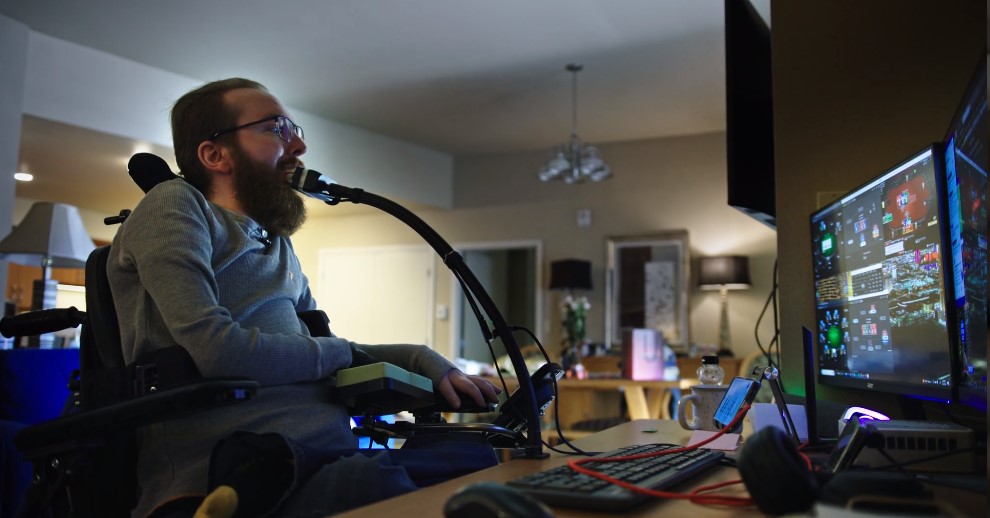The duality of my existence is shaped not just by my medical condition but by the world’s pace around me. In a world where speed, efficiency, and connectivity dominate, the Digital Age unfurls its wings, offering promises of empowerment and transformation. For many, technology is a tool, a means to an end. But for me, it’s more than just an accessory—it’s an extension of self, a lifeline that bridges the chasm between desire and capability. The limitations SMA imposes on my body have, in many ways, made technology my greatest ally.
One might wonder how technology melds so seamlessly into the life of someone with SMA. The answer lies in the synthesis of adaptive equipment and mainstream digital devices. A custom mouse, voice-activated software, specialized joysticks, and a plethora of other innovations ensure that the digital realm is as accessible to me as it is to anyone else. These devices, each tailored to accommodate specific needs, have become an intrinsic part of my daily routine.
Technology, with its transformative power, bridged the gap between my desires and abilities. My world began to expand with the creation and improvement of adaptive devices. The first time I utilized an adaptive device, it felt as if a door that had been sealed shut was suddenly flung open. With every click and beep, it whispered possibilities. Suddenly, tasks that were once considered insurmountable mountains transformed into navigable terrains. Whether it was typing out a message, scrolling through a webpage, or making a video call, each action was a testament to human ingenuity and its capacity to transcend limitations.
But it’s not only about the tangible, tactile experience of technology; it’s also about the intangible connections it facilitates. Social media platforms, online gaming, and video chats have allowed me to forge relationships beyond the confines of physical boundaries. I’ve laughed with friends from across a continent, engaged in intellectual debates, shared dreams, and celebrated milestones—all through the pixels of a screen. As the lines between the physical and virtual continue to blur, it’s evident that technology will play an increasingly pivotal role in the lives of many. For individuals like me, it represents more than just progress; it’s a beacon of hope, a testament to the boundless potential of the human spirit when coupled with innovation.
Yet, with all this tech at my disposal, my most invaluable tool has been my electric wheelchair. More than just a mode of transport; it’s an extension of me. It offers freedom, allowing me to navigate spaces and interact with the world in ways that would be impossible without it.
Equipped with a plethora of actuators, this wheelchair is a marvel of modern engineering. With just a nudge of the joystick, I can reposition myself with ease—raising or lowering, tilting backward or forward, and reclining to a comfortable position. It’s more than just comfort; it’s about control, the ability to make micro-adjustments that can mean the difference between discomfort and ease. The wheelchair isn’t just about mobility; it’s about autonomy.
Each button, each mechanism, and every small adjustment capability serves a purpose, granting me the independence that SMA might otherwise deny. But more than the tangible functionalities, my wheelchair is a symbol. It’s an emblem of how adversity, when met with innovation and persistence, can lead to unexpected solutions and newfound freedoms.
However, while my wheelchair grants me immense independence, its efficacy largely hinges on the world around me. Every curb, every set of stairs, and every doorway not wide enough becomes a barrier. My wheelchair can have all the technology in the world, but if the environment I’m trying to navigate isn’t designed with accessibility in mind, then my autonomy is curtailed. It’s akin to having a supercar but being limited to a cul-de-sac road.
The need for accessibility in the physical realm isn’t just about creating ramps or installing elevators. It’s about fostering an inclusive mindset—a realization that when we design for accessibility, we design for all. The benefits aren’t restricted to those with disabilities. A world designed with inclusivity in mind is one where parents with strollers, elderly individuals with walkers, and anyone needing a bit of assistance can navigate with ease.
As much as I cherish the digital realm for leveling the playing field, there’s no substitute for tangible, real-world interactions. The aromas of a bustling market, the vibrancy of a busy square, or the gentle rustle of trees in a park—these are experiences that digital screens can’t replicate. Hence, while we continue to advance in the Digital Age, we must ensure that our physical world doesn’t lag behind. As society races ahead, embracing every new digital trend and technological innovation, let us not forget the age-old wisdom of inclusivity. A truly advanced society is one where everyone, regardless of their physical capabilities, can partake in its many splendors.
I’d like to make this blog a bit more interactive, so I’ve created a Google Form that lets anyone send in questions or topics they would like me to explore. You can even submit anonymously, if you wish.
Tell me what you want me to write about. Nothing is off-limits, but I don’t guarantee I will create a post based on your input.
